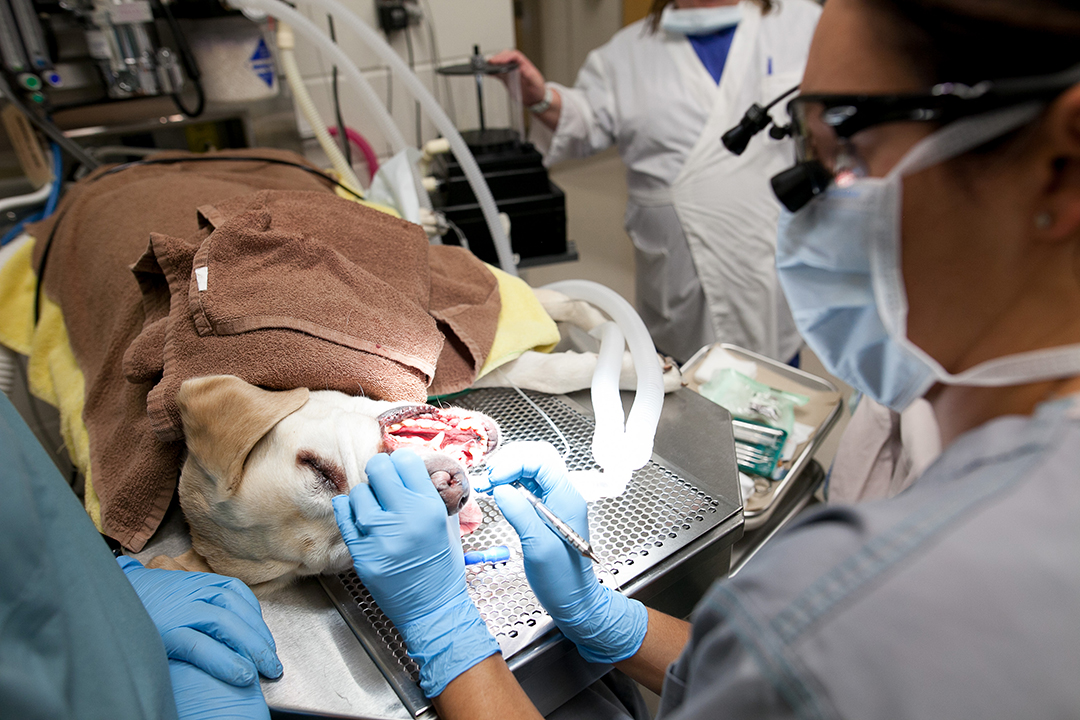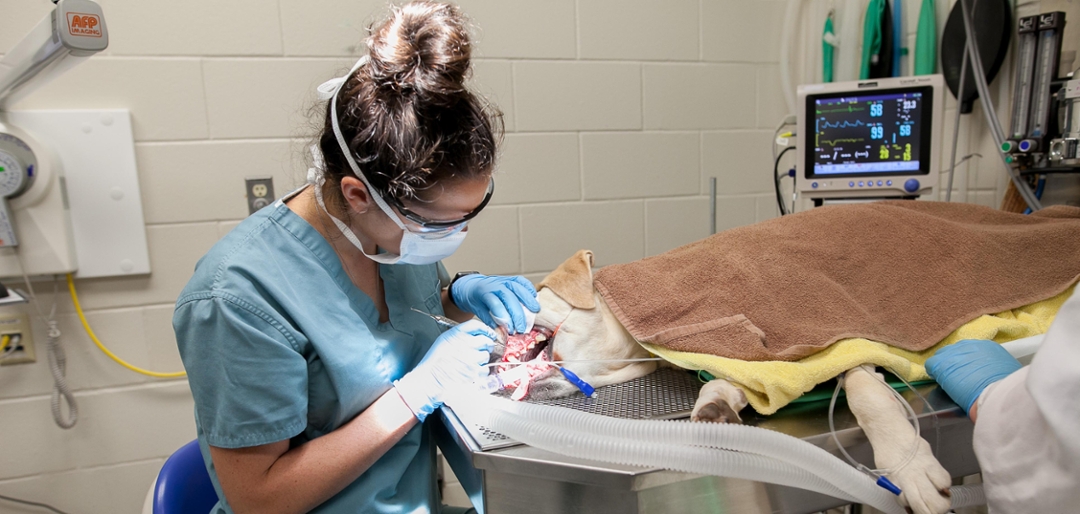
Brushing 'gold standard' for pet dental health
Bad doggy breath is no one’s best friend. It is also one of the most common signs of periodontal disease in pets.
By Katie Brickman-YoungTo help bring more awareness about pet’s oral health, February is National Pet Dental Health Month in Canada and the United States.
Dr. Candace Lowe, a board-certified veterinary dentist at the Western College of Veterinary Medicine (WCVM), shares signs of periodontal disease, how to reduce plaque, and the dental care products that pet owners can use.
“Periodontal disease is one of the most common diseases diagnosed in both cats and dogs in general practice,” says Lowe, an assistant professor in the WCVM’s Department of Small Animal Clinical Sciences.
Dental disease affects 80 per cent of adult dogs, and of all the oral conditions, periodontal disease is the most common.
Periodontal disease is an infection where bacteria eat away at the ligament that holds a tooth and the surrounding bone.
“Pretty much by three years old, every size, breed and animal will have some degree of periodontal disease,” says Lowe. “The severity increases with age — as they get older, the risk increases.”
The most obvious sign of dental disease is when a pet loses one or more teeth. Other signs of possible mouth problems that should be checked by a veterinarian include bad breath, broken or loose teeth, yellow-stained or plaque-covered teeth, abnormal chewing or drooling, reduced appetite, bleeding gums or blood on toys, mouth swelling, and a lack of interest in toys.
Lowe recommends getting your pet’s teeth checked at least once a year by your veterinarian. To effectively check for disease, dogs need to go under anesthesia for X-rays. Veterinarians use anesthesia to reduce the stress and pain for your pet and increase safety by ensuring their vital signs remain intact and protecting their lungs from foreign material during the procedure.
As Lowe explains, it’s impossible to conduct comprehensive oral health assessment and treatment (COHAT) while your pet is awake or even sedated. However, non-anesthetic dental procedures are becoming more common in Canada — a concerning trend.
“These procedures actually do more harm than good as they give people the false sense of security that the visible teeth are clean while the real disease is lurking below the gum line.”
Periodontal diseases and therefore extractions are more common in smaller breeds of dogs because of the shape and size of the mouth, crowding issues and rotated teeth. Dogs that have malocclusions (under-bite or over-bite) are also more prone to periodontal disease.
“Cats and dogs can do fine without all their teeth and live happier, longer lives if we have to remove infected teeth,” says Lowe, who stresses the link between animals’ dental health and their quality of life.

The key to having healthy teeth and a healthy mouth starts at home with a daily teeth brushing routine.
“Daily brushing is the gold standard in the hope you at least do it every other day,” says Lowe. “Regularly brushing, using safe dental chews and other certified products can reduce the frequency of dental cleanings for your pet.”
There are many products available at pet stores for dental or oral health, but not all products are effective. Lowe suggests talking to your veterinarian about their recommendations for any dental products, treats or dental diets.
When looking for dental products, toys or other pet items, be sure to look for the Veterinary Oral Health Council (VOHC) label. Products carrying this label meet the VOHC’s standards for effectiveness in delaying plaque and tartar build up.
“There are some dog toothpastes that have been shown to decrease plaque, while there are others that are just flavoured lubricants that entice your pet to accept the brushing process,” says Lowe.
Another beneficial product is dental diet dog food. Most of the hard kibble available on the market will burst in the dog’s mouth when the tip of the tooth hits a piece. But with a dental diet, a dog has to grind its tooth through the food, helping break down plaque and tartar on the back molars.
“A dental diet will help in the back of the mouth, your brushing will help with the front of the mouth, and using a gel or rinse will also help to reduce plaque which initiates periodontal disease. It is important to realize it is not the be-all and end-all. Unfortunately there is no magic bullet that will completely eliminate the need for COHATs — if there was, humans would use it!” says Lowe.
Toys are another product that owners should carefully watch for – toys or chews that have no give should be avoided as they increase the risk of broken or fractured teeth.
“A general guideline is if you wouldn’t hit yourself on the kneecap with it, it’s too hard,” says Lowe. “Any toy that doesn’t bend or have any give shouldn’t be used by your dog.”
The best way to start a routine with your pet is to visit your veterinarian and have both an oral exam and dental X-rays completed. This information will allow your pet’s clinical team to make an accurate treatment recommendation, which can range from a prophylaxis (cleaning), tooth extractions or even root canals. Then you can establish a daily brushing habit with your pet to maintain its healthy mouth.
Article re-posted on .
View original article.

